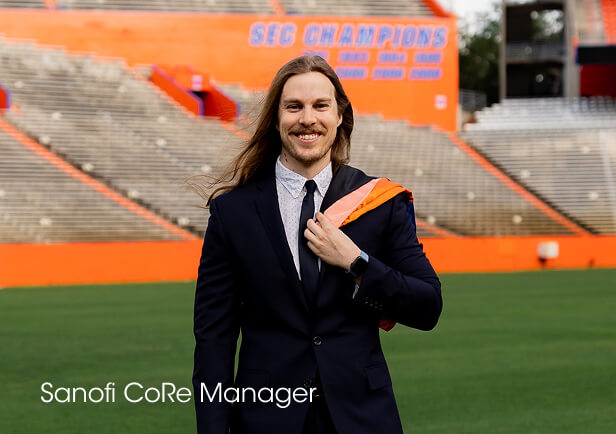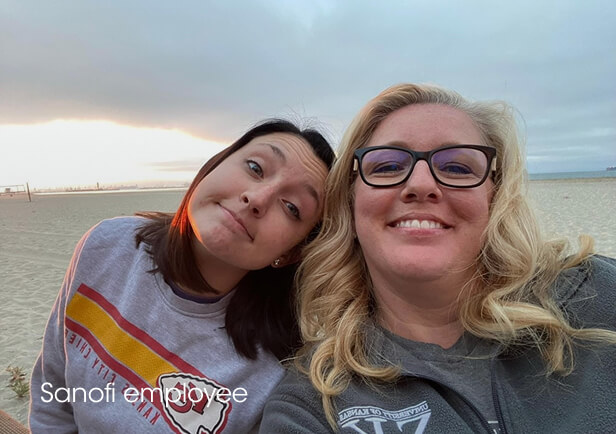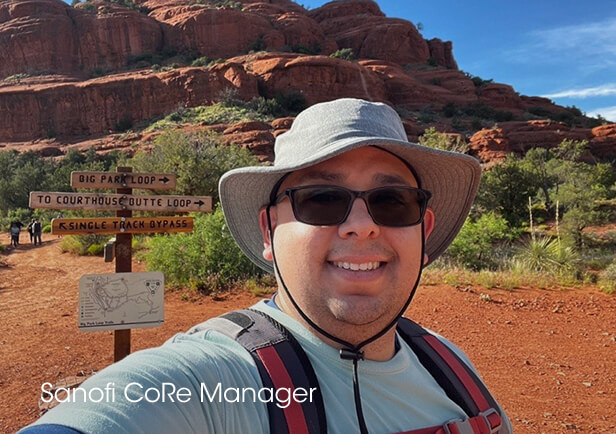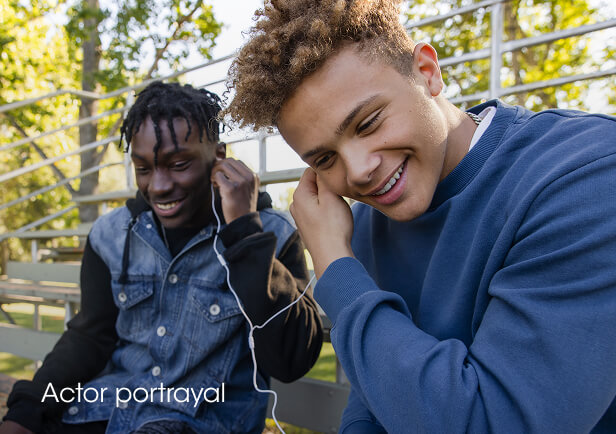Through my daughter’s eyes.
Jane’s daughter, Taylor, shares how her brother’s hemophilia has helped her find her own identity.
Jane Cavanaugh Smith, Head of U.S. Rare Blood Disorders Public Affairs + Advocacy at Sanofi
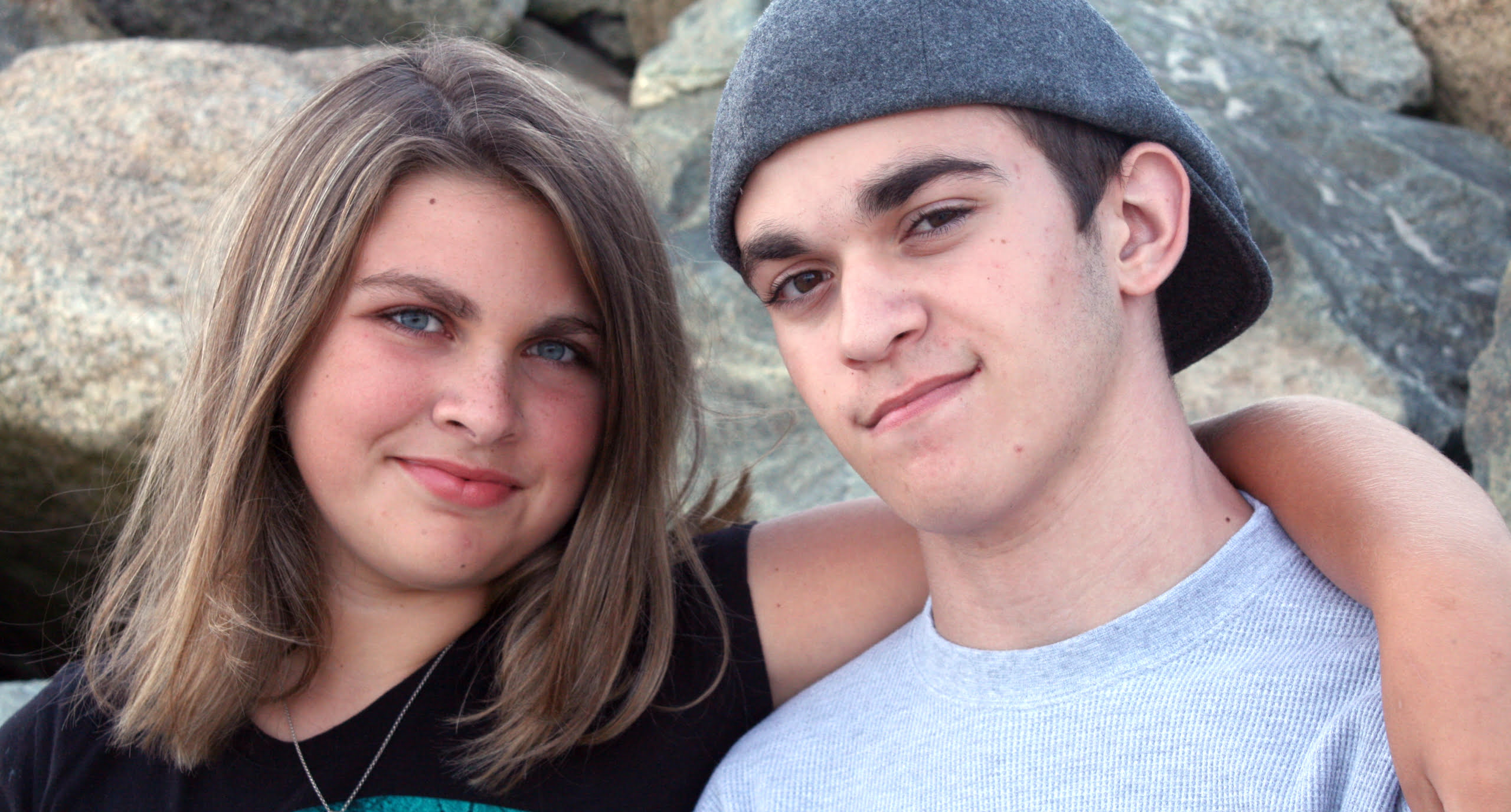
Sanofi employee's family members
When she was only four years old, Taylor’s grandmother described her as being very capable.
It’s an unusual term to use for a small child, but it’s been true her whole life.
Taylor’s capability, in part, stemmed from her older brother Leland’s hemophilia.
As a child, she had to adjust to
emergencies and uncertainty—something that has helped her
become an incredibly empathetic person.
I’ll never forget one time after I had spent a few days in the hospital with Leland when Taylor was about eight years old.
I was exhausted when we
got home and just wanted to crash on the couch watching TV.
Out of nowhere, she comes in with a tray of Chicken Parmesan with ginger ale in a nice
glass.
She had called a neighbor to figure out how to make it because she knew it was my favorite.
Recently, Taylor and I sat down to talk about what it’s like to be a sibling to someone living with hemophilia. Here’s her experience in her own words.
The protector, from a Distance
Like most younger sisters, I always wanted to be very involved in my older brother Leland’s life. He definitely saw me as the annoying little sister, but I put a lot of effort into getting him to like me. I would give him toys that were very special to me—like my most prized possession “puff-puff” blanket to comfort him while he was getting his infusions for hemophilia. I wished for his friendship so much that I offered up my Barbies when he used his infusion tourniquets to slingshot whatever he could get his hands on across our backyard. I saw how much joy that brought him and loved that I could be a part of it.
When I think back, there’s no point in my childhood when hemophilia wasn’t a part of it, and it has always fascinated me. As I got older, my mom would let me help with Leland’s infusions. I distinctly remember learning how to mix his factor and always trying to do it the same way my mother did. What I wasn’t quite aware of was that the familiar clicking noise that I had heard when my mom was rolling the vials between her hands to reconstitute the medicine was from her wedding band. For the longest time, I thought I was doing it wrong because it didn’t make the same noise for me.
Leland had developed an inhibitor as
a baby, which is an immune response
that produces antibodies, and it prevented his treatment from working.
When I was eight, his health took a turn for the worse. He spent more
time at home and in the hospital for pain management and multiple
surgeries.
His severe and frequent bleeding episodes combined with our
transition into adolescence created complexity and distance in our
relationship.
Part of the distance was because Leland and my mom shared a very unique experience. I would get jealous of the time they spent together, and I also had mixed feelings when my mom made hemophilia part of her career. One was happiness with all the fun things to do, like going to hemophilia camp or hanging out with kids with similar experiences. But I also had moments where I didn’t want to share my mom with everyone.
When I went to hemophilia camp, it was an odd feeling to see other
families and describe them as having the “normal hemophilia experience.”
Because of Leland’s inhibitor, that wasn’t our family’s reality. When
Leland was in a wheelchair or limping due to internal bleeding into his
joints, it couldn’t be hidden. Instead of asking questions, my friends
and peers often resorted to pity for a condition that they were unable
to understand. I had always hoped that they would ask questions and not
just feel bad for us.
Another part of the distance, which I didn’t realize at the time, was that the severity of his situation made me feel like a caregiver. I coped with the difficult situation by doing things for my family, trying hard in school, and working as hard as possible so my parents could focus on Leland. That was my way of having control over the unpredictable. I also found myself self-isolating, which I knew wasn’t healthy, but I would pretend that things weren’t happening and keep to myself.
One of my strongest memories is when Leland was a teenager and he
confided in me for the first time. He was going through tough pain
management post-surgery. Our bedrooms were next to each other, so he
came in and he said, “You might want to turn your TV up tonight because
I’m going to be in a lot of pain.” Being in pain and expressing
that was
not new, but this moment to acknowledge how it would impact me was. That
was the start of a change in our relationship where I felt like we
understood each other.
Finding my own identity
When I was young, my mom and I would talk about being a carrier of a hemophilia gene. I knew there was a 50/50 chance I had also inherited the gene. I wanted to be just like her since she was a carrier of the hemophilia gene and I really wanted hemophilia to be part of my life moving forward. When I was 16, I had genetic testing, which came back negative. I do not carry the hemophilia gene and no longer had to plan for the potential of having my own child with hemophilia. I remember having mixed feelings about that.
Hemophilia will always be a part of my life, but when I started feeling comfortable venturing beyond hemophilia, I had independence and realized I could create my own identity. And today I have never been more comfortable in my own skin. Even better, the best part of the process of finding myself was that my relationships with others grew.
My mom and I find ways to connect. One of our favorites is to explore different restaurants together. Wherever we go, it’s a joint decision of what we’re going to order so we can share. One person is getting a salad, but the other one better get fries.
My relationship with my brother has
also grown strong. We’re good at
communicating and can talk about anything as friends; we find ways to
work through struggles together. Last time we saw each other in person,
we stayed up until two o’clock in the morning just talking.
While my brother having hemophilia definitely impacted me, it has equally gifted me with maturity and the drive to find my own identity. For siblings of those living with hemophilia, I’d encourage them to explore life outside of the hemophilia community and remember how important it is to be a strong advocate for your own needs.
Each patient story reflects the real-life experiences of individuals diagnosed with hemophilia. Individual experiences may vary. For medical advice, please consult your own healthcare provider.

